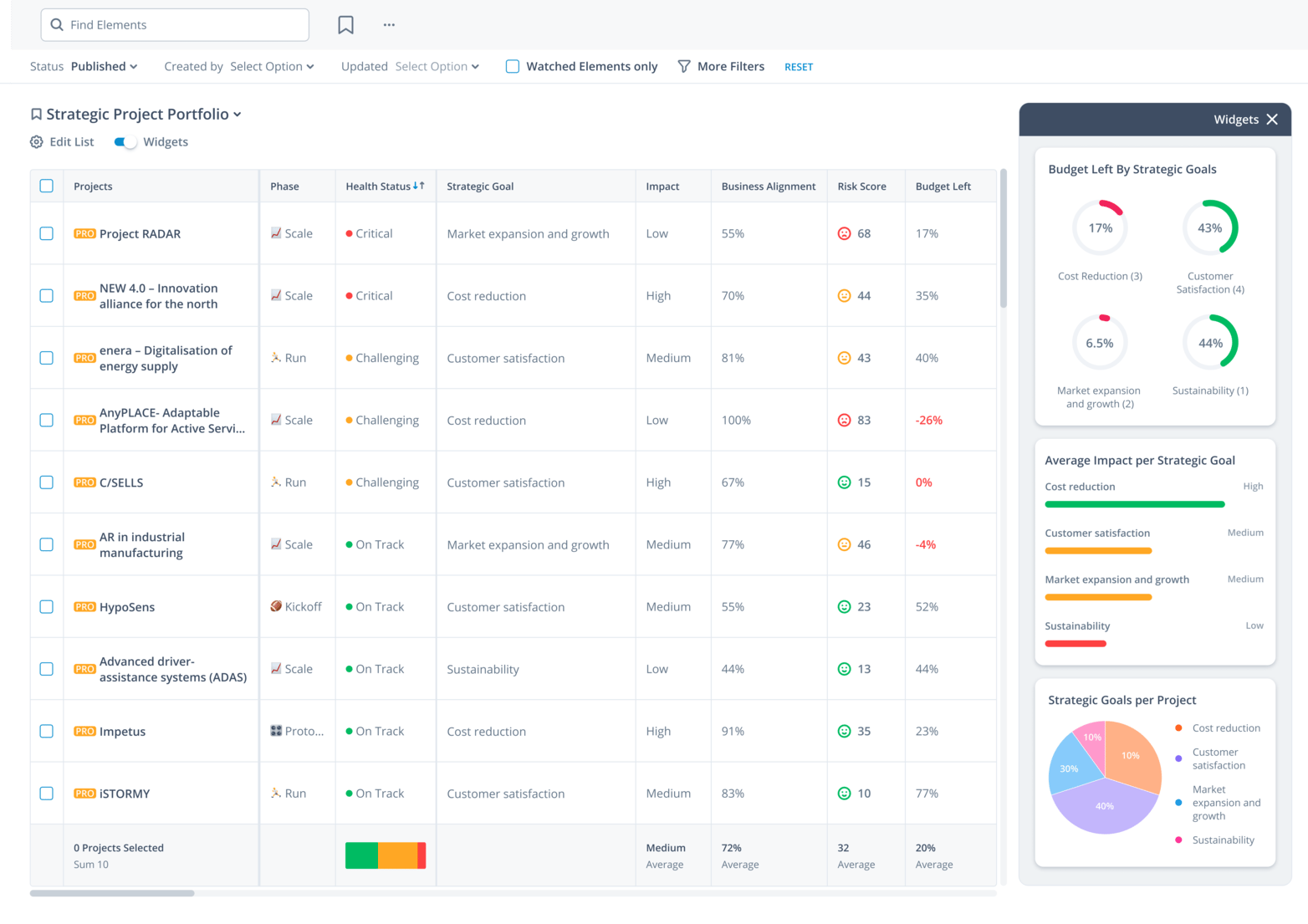Organizations around the world invest a staggering amount in research and development (R&D) initiatives. Amounting to nearly $2.5 trillion in 2022, annual R&D spending is equivalent to around 2% of global GDP.
So, how do directors of R&D departments and chief technology officers make sure that these dollars are well spent, maximizing their potential for innovation and return on investment? It begins with the recognition that effective R&D management is not just about allocating resources but also about syncing R&D with business objectives, market developments, and the increasing speed of change.
Having collaborated with some of the world’s more innovative companies, we’ve uncovered three main themes that productive R&D teams exemplify. These include embracing agile innovation processes, strategically and ethically integrating artificial intelligence (AI), and embracing diversity and inclusion. Drawing insights from thought leaders, industry experts, and innovation leaders, this blog delves into effective strategies for delivering sustainable, R&D-led growth.
Agile innovation processes in R&D
R&D teams face the persistent challenge of maintaining relevance amidst an ever-shifting technological and market landscape. AI represents just one, if not the fastest-advancing, most game-changing technological field in which R&D teams must maintain relevance, but there are countless others. And the stakes have never been higher. With more than 75% of business executives believing that their companies’ current business models will fail to be economically viable by 2025, the onus to drive growth has fallen on R&D and innovation.
For R&D teams laden with this heightened responsibility, embracing agile innovation processes is essential. This means not only deploying advanced technologies like AI but also integrating robust, flexible methodologies that can swiftly respond to both technological advancements and evolving market needs. By adopting a proactive and strategic approach, R&D teams can drive the disruptive innovation that sustains business models, creating new avenues for growth and competitiveness.
Continuous, iterative development
Many traditional approaches to R&D are project-based and lack continuity with business goals. By emphasizing an ongoing commitment to improvement over one-time breakthroughs, continuous innovation allows companies to adapt to rapidly changing environments and seize new opportunities.
The Kaizen philosophy: Andrew Willett, Senior Expert at Toyota Motor Europe, describes the company’s unwavering commitment to continuous improvement, transparency, and respect for people, both customers and employees. Approaching R&D through this “Kaizen” lens empowers teams to adapt to change and disruption by fostering a culture of ongoing learning and iterative development, ensuring that innovations are consistently aligned with evolving market demands and technological advancements.
Phased innovation processes: Hans Lind, Director of Business Innovation & Foresight at Volvo Group, details the approach taken within the Volvo Connected Solutions Innovation Lab to ensure its R&D processes are flexible and responsive. The lab's phased innovation methodology—discovery, incubation, and acceleration—is structured yet agile enough to allow its R&D team to experiment with new ideas while moving the most viable innovations forward.
Use ITONICS to systematically move ideas, projects, and other R&D assets forward, identify bottlenecks, and streamline delivery. With workflows in ITONICS, you can configure phase-gate processes with custom phases, like Volvo’s discovery, incubation, and acceleration. Automate tasks and responsibilities in each phase and incorporate collective evaluation to ensure only your most promising initiatives move forward on their way toward efficient execution.
Data-driven decision-making
In an era dominated by big data, R&D teams must harness comprehensive, high-quality data to fuel innovation and ensure their solutions meet real-world demands. This approach sharpens decision-making while enhancing the predictive capabilities of emerging technologies like AI.
Centralizing data: Dolby Laboratories’ Futures Council uses the ITONICS Innovation OS to centralize data across departments and foster collaborative intelligence. Former Head of Foresight at Dolby, Tessa Finlev, explains how this approach ensures that strategic planning and innovation are informed by a comprehensive analysis of relevant data—accessible to everyone in the company. With a single source of truth, R&D teams can make decisions faster, in alignment with future market demands and technological trends.
ITONICS Lists provides R&D managers with a 360-degree view of their portfolio. Lists eliminates the need to switch between spreadsheets and various documents, empowering decision-makers to act with the speed and confidence that comes from data-driven insights. Monitor R&D performance, budget, and KPIs in a single point of truth, in real-time, with this dynamic tool—equipped with interactive editing, filtering, and sorting.

Multi-source information gathering: Data-driven decision-making is only as good as the data you base it on. That’s why the Ericsson ConsumerLab, led by Jana Uthayakumar, employs a multi-source information-gathering strategy. This method integrates expert interviews, extensive primary research, and vigilant media monitoring, ensuring a broad and informed perspective essential for R&D teams navigating uncertain technological territories.
Strategic and ethical integration of AI in R&D
Integrating AI into R&D workflows has become a strategic imperative to drive innovation and maintain competitive advantage. The escalating complexity of technological landscapes and the acceleration of market demands necessitate that R&D teams not only adopt AI but also master its strategic deployment.
The benefits of integrating AI into R&D processes are many: faster time to market, improved customer satisfaction, increased revenues, and decreased costs. However, these aren’t preordained outcomes following AI adoption. McKinsey analysis shows that “AI power users” prescribe to a set of best practices that are key in scaling AI’s impact while mitigating potential risks. These best practices include aligning AI strategy with business goals, investing in AI talent and training, and establishing standard protocols and repeatable processes.
Ethical AI frameworks
The integration of AI within R&D must be underpinned by robust ethical frameworks to ensure the technology is used responsibly. This involves crafting comprehensive guidelines and supervision that address potential biases, ensure transparency, and protect privacy.
Ethical considerations and risks: With the integration of AI into new technologies like spatial computing, Leslie Shannon, Head of Trend and Innovation Scouting at Nokia, highlights the potential ethical risks and the need for careful consideration of privacy and data security. R&D leaders must ensure that their teams not only push the boundaries of technological innovation but also consider the broader societal impacts and ethical implications of their work.
The role of humans in AI supervision: Even as AI becomes more advanced, the need for human oversight remains crucial. Andreas Welsch, Chief AI Strategist at Intelligence Briefing and Adjunct Lecturer at West Chester University of Pennsylvania, discusses the necessity for humans to tweak and review data inputs to avoid perpetuating biases and errors. For R&D leaders, it’s a reminder of the value of human judgment in overseeing and guiding the direction of technological solutions, ensuring they align with ethical standards and real-world applicability.
Robust data governance
Data is the lifeblood of AI systems, and its integrity is paramount for generating reliable insights. Implementing stringent data management practices ensures the information feeding into AI systems is accurate and unbiased.
Data-driven innovation: Dr. Christoph Nabholz, Chief Research Officer and Head of the Research, Engagement & Sustainability Team at the Swiss Re Institute, underscores the importance of robust data collection and analysis in developing AI models for risk management. This approach is crucial for R&D teams working on applications like AI in modeling, predictive analysis, and sensemaking, where data quality directly influences the effectiveness and reliability of the outcomes.
Human-centric data challenges: Andreas Welsch of Intelligence Briefing points out that a significant issue with AI, and by extension in technology development, is the reliance on human-generated and curated data. This impacts the accuracy, fairness, and functionality of AI systems. For R&D teams, this underscores the importance of critical data management and the need to maintain high-quality, unbiased data sources during development phases.
Embrace generative AI for foresight: Jana Uthayakumar, Global Foresight, Data & Analytics Lead from the Ericsson ConsumerLab sees immense potential in using generative AI to generate diverse scenarios and help visualize complex futures. This can be a significant tool for R&D teams to reduce uncertainty about future technologies and market trends. But he warns, “What we need to be careful about is that we don't fall into the trap that high volume is better. Just because you can generate a high volume of scenarios in an instant doesn't mean it's better.” Critical evaluation and strategic alignment of AI-generated assets—scenarios, ideas, trends, etc.—is imperative.
Diversity and inclusion in R&D
Leaders who encourage a culture that is inclusive and values diverse opinions are building foundations that are shown to be more innovative and adaptable to the unpredictable dynamics of global markets. A study by BCG and the Technical University of Munich underscores a direct correlation between the diversity of management teams and the innovation outputs in terms of revenue from new products and services.
But it’s not only in leadership roles where diverse perspectives enhance innovation. Embracing diversity in R&D teams can significantly expand creative capacity and problem-solving prowess. Diversity in gender and ethnicity, as well as in experience, industry background, and career paths, all contribute to a richer pool of ideas and a more robust innovation process.
Diverse team composition: Hans Lind from Volvo Group emphasizes the importance of assembling a diverse team within the Volvo Innovation Lab, noting that team members come from various countries and have different backgrounds. This diversity is critical as it brings a wide range of perspectives and ideas, which is crucial for innovation, especially in an R&D setting where tackling complex problems often requires out-of-the-box thinking.
Inclusivity in technology development: Nokia’s Leslie Shannon stresses the need for more inclusivity in the tech industry, not just in terms of demographic diversity but also in incorporating diverse professional backgrounds and perspectives. This is reflected in Toyota’s approach to innovation as well, where the automotive company encourages all employees to contribute ideas and provide feedback. Inclusivity in R&D ensures that solutions are well-rounded and meet diverse user requirements.
An operating system for R&D
The ITONICS Innovation OS is a comprehensive operating system designed for end-to-end innovation, product development, and R&D management. It centralizes, streamlines, and aligns all aspects of R&D efforts across your organization, ensuring that every phase of the innovation process—from strategy to execution—is interconnected and optimized for success.
By facilitating agile innovation processes, the Innovation OS promotes a dynamic approach to development that swiftly adjusts to changing market demands and emerging technologies. It encourages the incorporation of diverse perspectives through open innovation and collaborative evaluation, enriching the innovation pipeline with a broader range of ideas and insights.
Powered by AI and fed with a robust, live data feed, the ITONICS system enhances analysis and decision-making, providing R&D teams with actionable insights and intelligence to drive forward-thinking strategies. These capabilities empower R&D teams to shape the future of their industries by staying ahead of technological trends and market shifts.











